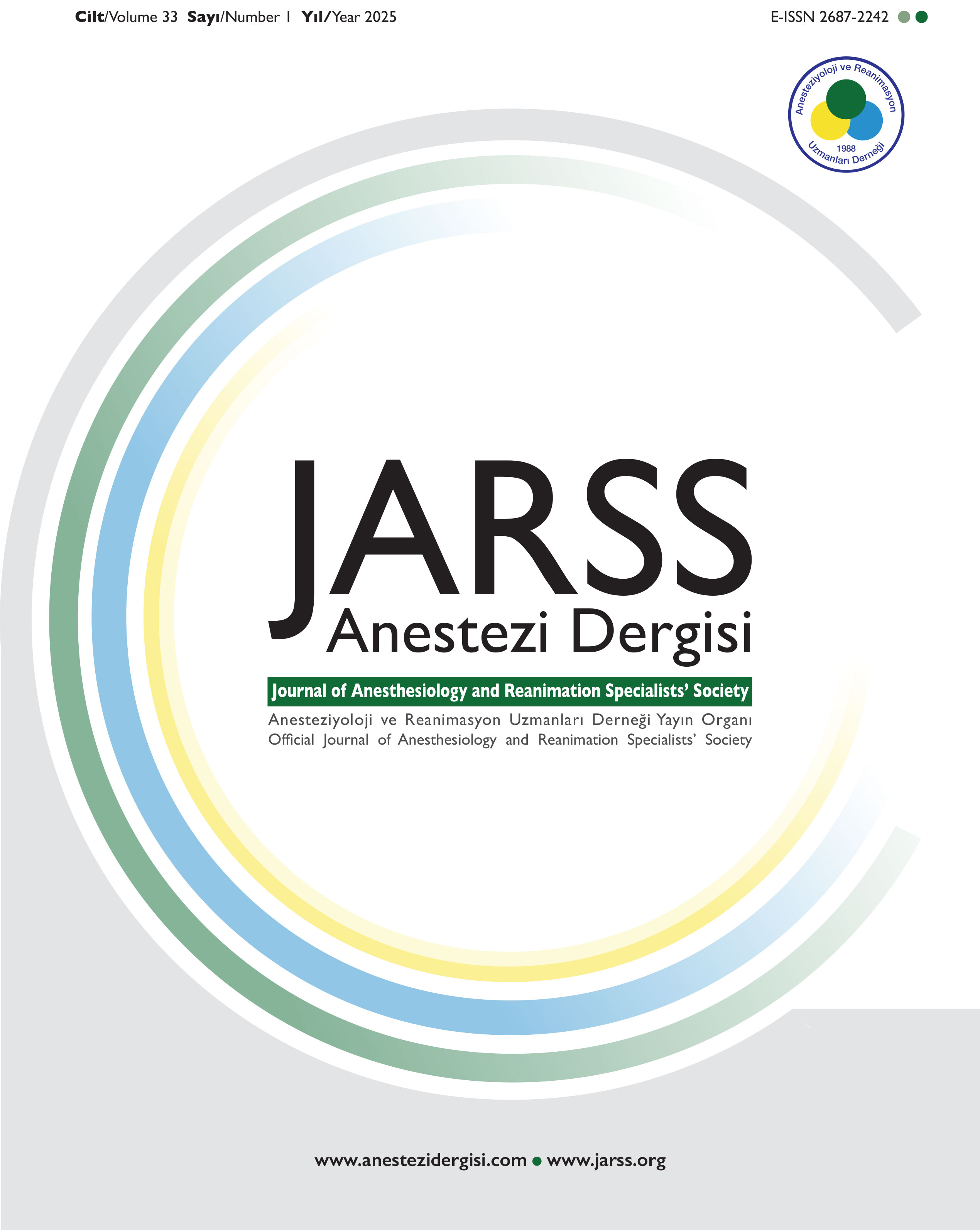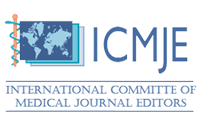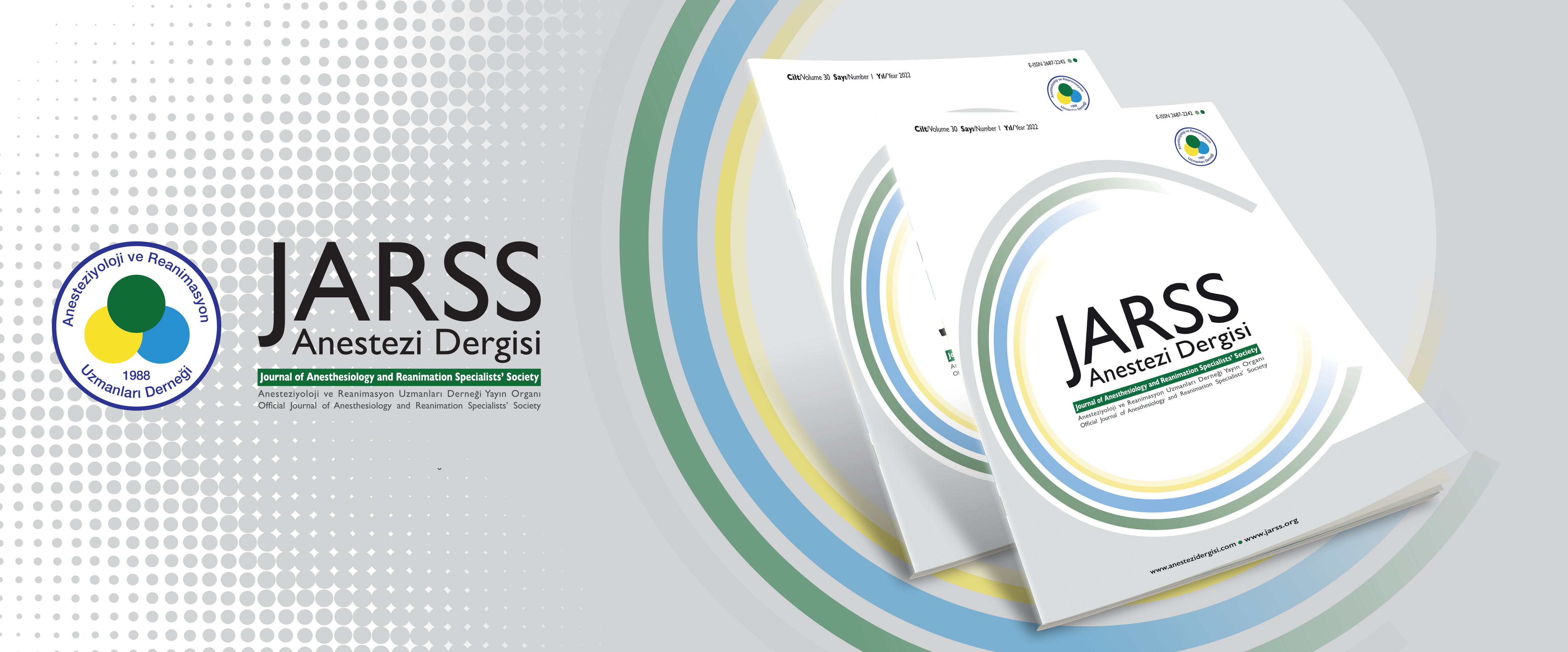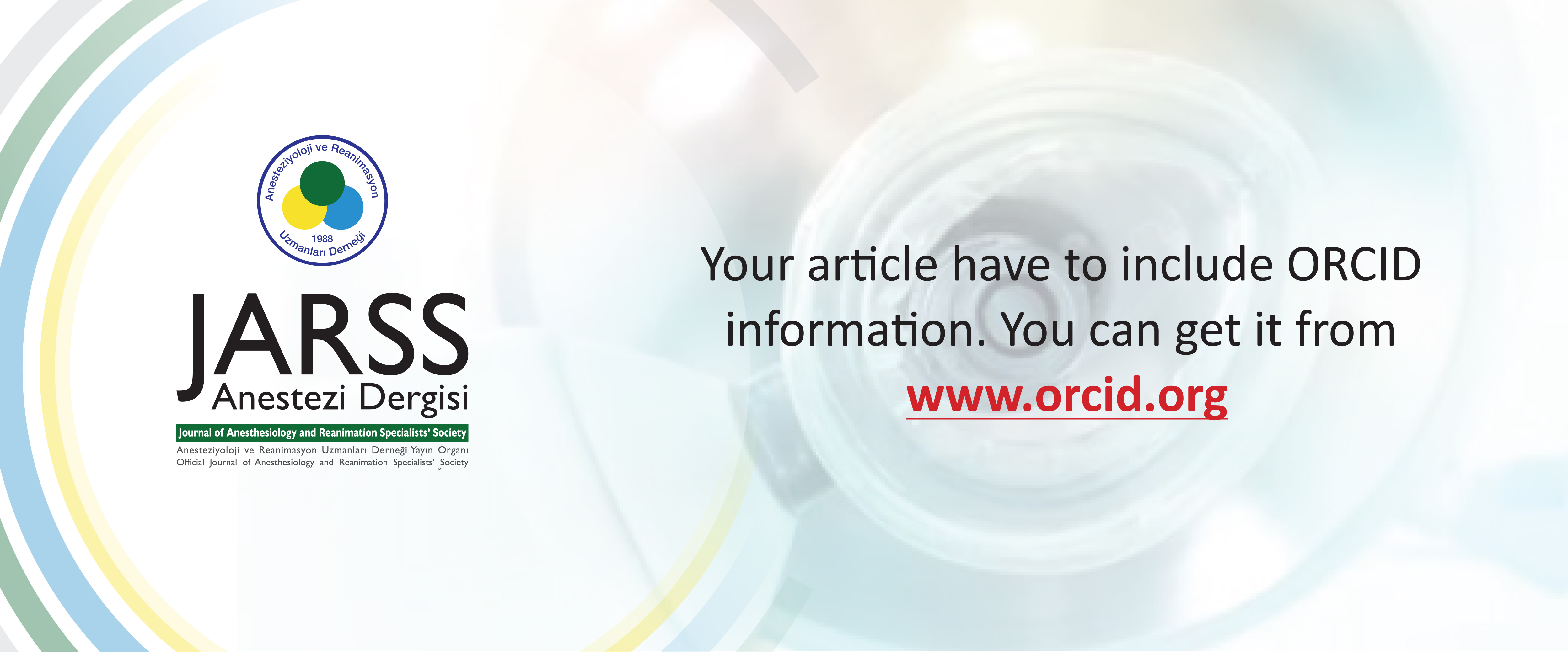Volume: 28 Issue: 3 - 2020
| 1. | Cover Page I (619 accesses) |
| REVIEW | |
| 2. | Preoperative Preparation and Operating Room Management of the Patients Who have Confirmed or Suspected COVID-19 infection Hatice Türe, Şüheda Çelebi, Ezgi Aytaç, Ayşe Tuğluoğlu Kuşdemir, Birsel Ekici, Abdulvahap Oğuz, Tuğhan Utku, Ferdi Menda, Meral Sonmezoglu doi: 10.5222/jarss.2020.70299 Pages 137 - 149 (4657 accesses) Objective: The virus, called Covid-19 pandemic, spread from Wuhan, China to the whole world in December 2019. It poses a risk to healthcare professionals due to patients and asymptomatic cases carrying the disease. In particular, operating theaters are among the most risky work areas in terms of aerosol forming processes and possible contact. For this reason, the establishment of perioperative operation protocols are essential. In this study; characteristic of the pandemic period; Our “preoperative patient preparation and operating room operation protocols” including preoperative patient preparation, operating room organization and personal protection equipment are presented. Method: For this purpose, existing protocols and literature scanning have been made and the protocol created in the light of current information; It includes 3 sub-titles: preoperative patient preparation, regulation of operating room operation, operating room cleaning at the end of the operation. Results: The protocol created was used between 15 March and 10 May 2020. When the perioperative management is exactly implemented in line with our protocols created in accordance with the internal functioning of our institution, it has been observed that the operation does not fail, besides patient and employee safety. Conclusion: In the light of clinical protocols, COVID-19 suspected-infected patients can be identified in the preoperative period, and perioperative risks can be reduced and the safety of the patient, healthcare professionals and other patients can be increased. |
| ORIGINAL RESEARCH | |
| 3. | The Value of SCUBE-1 on Ischemia-Reperfusion Model in Diabetic Patients during Knee Replacement Surgery Savas Altinsoy, Basak Gulel, Derya Özkan, Ali Yalcindag, Lütfiye Tuba Hancı, Asli Donmez doi: 10.5222/jarss.2020.80664 Pages 150 - 157 (845 accesses) INTRODUCTION: Diabetes Mellitus (DM) is a common disease with high mortality and morbidity worldwide. We aimed to assess and compare the oxidative stress level between patients with, and without DM who underwent knee replacement surgery using a pneumatic tourniquet, and whether signal peptide-CUB-EGF domain-containing protein 1 (SCUBE-1) levels are correlated with other ischemia reperfusion (IR) markers such as malondialdehyde (MDA), and total antioxidant status (TAS). METHODS: Patients were assigned into either the diabetic (group D; n =15) or non-diabetic group (group C; n=15). MDA, TAS, and SCUBE-1 were assessed at three periods: before spinal anesthesia (T1), 5 minutes before (T2) and 2 hours after deflation of the tourniquet (T3). RESULTS: Demographic variables of the groups were similar. There were no statistically significant differences in SCUBE-1, MDA and TAS levels of both groups at all time points. SCUBE-1 levels were higher at T2 and returned to almost normal levels at T3. DISCUSSION AND CONCLUSION: SCUBE-1 concentration, MDA and TAS increased following tourniquet application and decreased during the reperfusion period. The degree of increase, however, didn’t differ between patients with or without DM. Our results suggest that SCUBE-1 may be used as a marker of tourniquet-related ischemia-reperfusion model. |
| 4. | The usage of herbal products among patients scheduled for surgery and the effect of herbal products on neutrophil-lymphocyte ratio: a cross-sectional study Ali İhsan Uysal, Başak Altıparmak, Melike Korkmaz Toker, Semra Gümüş Demirbilek doi: 10.5222/jarss.2020.95866 Pages 158 - 162 (1107 accesses) INTRODUCTION: Herbal medicines are increasingly used. There are publications in the literature reporting that approximately 80% of the world population uses herbal products. Since many patients do not accept herbal products as medicines, they do not state that they used herbal products before surgery. Herbal products are known to have many side effects. The primary purpose of the study is to investigate the use of herbal products among the patients planning surgery through a questionnaire prepared. Secondary, it was aimed to compare the neutrophil lymphocyte ratio of patients who used herbal products in the last 1 month with other patients. METHODS: A questionnaire consisting of 11 questions was administered to the patients in the anesthesia policlinic for 3 months. After completion of the questionnaire, neutrophil and lymphocyte levels on the current hemogram were recorded RESULTS: The questionnaire was administered to a total of 445 patients. 159 of the participants stated that they have been using herbal products so far, while 39 of them stated that they have been using them in the last month. While there was no statistical difference in educational status of users and non-users of herbal products, there was a difference in terms of age and gender. 280 patients stated that the usage of herbal products was not questioned during previous surgeries. Neutrophil-lymphocyte rates were lower in herbal products than in non-users. DISCUSSION AND CONCLUSION: Potential problems of herbal products are coagulation disorder (bleeding and anticoagulation), cardiovascular side effects (hypertension, edema and cardiac rhythm impairment), water and electrolyte disorder (sodium retention and hypokalemia), hepatotoxicity and prolongation of anesthetic agents (confusion and sedation), endocrine effects (hyperglycemia and hypoglycemia). Neutrophil / lymphocyte ratio is an indicator that is calculated by using neutrophil and lymphocyte values and its popularity is increasing day by day. Anesthesiologists should pay more attention to the use of herbal products. |
| 5. | Comparison Of Percutaneous Tracheostomy Process In General Intensive Care Units With Or Without Fiberoptic Bronchocopy Guidance Zerrin Özçelik, Yücel Gültekin doi: 10.5222/jarss.2020.52714 Pages 163 - 169 (1025 accesses) INTRODUCTION: Percutaneous dilatational tracheostomy(PDT) is a routine procedure in the intensive care unit. PDT can be performed by using fiberoptic bronchoscopy (FOB), that it increases safety.and causes less complications and tissue damage. The aim of this study was to determine whether the use of a FOB decreases the complication rate and improves safety. METHODS: PDT cases performed with or without FOB by Griggs method between January 2017 and January 2018 were evaluated retrospectively. The age, gender, intensive care hospitalization and PDT opening diagnoses, the time (days) until the opening of the tracheostomy and total procedure time, mortality were obtained from patient documents. Complications observed in the first 24 hours were evaluated as early and 24 hours later as late complications. Minor bleeding (< 10 mL), hypotension, arrhythmia, hypercapnia, hypoxia were considered as minor complications. Major hemorrhage, pneumothorax, hemothorax, false passage, subcutaneous emphysema were defined as major complications. RESULTS: During the study, 103 intensive care patients data recorded retrospectively. PDT procedure was performed without FOB in 44 patients (42.7%) and with FOB in 59 patients (57.3%). During the procedure, SaO₂ values were found as 98% (93%,100%) and 75% (40%,100%) in without and with FOB groups. Total PDT procedure duration was 20 ± 6 minutes in without FOB group and 25.2 ± 6 minutes in with FOB group. Fourteen patients (31.8 %) developed early complications and 6 patients (13 %) major complications in without FOB group. The rate of early complications during the FOB-PDT group was 13.5 % (8 patients). One patient (1.7%) developed major bleeding. Tracheoesophageal fistula was observed in one patient (1.7%) on 270th day in intensive care unit in with FOB group. DISCUSSION AND CONCLUSION: We think that it is safer to perform PDT with FOB. Although the duration of FOB-guided PDT procedure was longer, we found that the complications of the procedure were reduced. |
| 6. | Ultrasound-Guided Erector Spinae Plane Block and Thoracic Paravertebral Block for Postoperative Analgesia Management Following Video-Assisted Thoracic Surgery: A Prospective, Randomized, Controlled Study Bahadır Çiftçi, Mürsel Ekinci, Erkan Cem Çelik, Ismail Cem Tukac, Birzat Emre Gölboyu, Mehmet Zeki Gunluoglu, Yunus Oktay Atalay doi: 10.5222/jarss.2020.07769 Pages 170 - 178 (1966 accesses) INTRODUCTION: Evaluation of the ultrasound (US)-guided erector spinae plane block (ESPB) and thoracic paravertebral block (TPVB) compare to no intervention control group for postoperative pain management in video assisted thoracic surgery (VATS) patients. METHODS: Three groups - ESPB group, TPVB group and control group (n = 30 per group) were included in this prospective, randomized, controlled study. The US-guided blocks were performed preoperatively in the ESPB and TPVB groups. Intravenous patient-controlled postoperative analgesia via fentanyl was administered in all of the patients. Postoperative pain was assessed via visual analogue scale (VAS) scores, opioid consumption, and adverse events. RESULTS: The fentanyl consumption and VAS at all time intervals was significantly lower both in ESPB and TPVB groups compared to the control group (p < 0.001). Block procedure time was significantly lower and success of one time puncture was higher in group ESPB as compared with that in group TPVB (p < 0.001). DISCUSSION AND CONCLUSION: ESPB and TPVB provided more effective analgesia compared to control group following VATS. ESPB had a shorter performance time and higher success of one-time puncture compared to TPVB. |
| 7. | The Efficacy of Ultrasound-Guided Erector Spinae Plane Block for Postoperative Analgesia in Laparoscopic Cholecystectomy. A Retrospective Cohort Study Omer Karaca, Huseyin Ulaş Pınar doi: 10.5222/jarss.2020.02886 Pages 179 - 187 (1190 accesses) INTRODUCTION: Laparoscopic cholecystectomy (LC) causes modere to severe pain. Although it is a minimal invasive surgery. The present study was planned to evaluate the efficacy and safety of bilateral erector spinae plane block under ultrasound (ESPB). METHODS: A total of 234 patients who underwent LCs between April 2017 and November 2018 were retrospectively analyzed. Two hundred patients were divided into two groups: The Control Group (Group c, n=100) who received only intravenous (iv) patient-controlled analgesia (PCA) and the ESPB Group (Group E, n=100) who received bilateral ESPB (bupivacaine 0.25, 50 ml) and iv PCA. Also, the block related complications were recorded. RESULTS: The numeric rating scores in the Group E were lower at the post-anesthetic care unit (PACU),1st, 2 nd, 4th, 6th hours (p<0.0001) and 8th hour (p<0.05). The fentanyl consumption during postoperative period was lower in the Group E (p<0.0001). PACU and hospital stay durations were shorter in the Group E (p<0.0001). The rescue analgesic need was lower in the Group E (p<0.0001). Intraoperative fentanyl requirement was lower in the Group E (p<0.0001). The unassisted walking time was shorter in the Group E (p<0.0001). The incidence of nausea and vomiting was lower in the Group E (p<0.05). No block-related complications were encountered. DISCUSSION AND CONCLUSION: Bilateral ultrasound guided ESPB provide superior analgesia and shortens unassisted walking time and hospital stay after laparoscopic cholecystectomy. |
| 8. | Comparing the Prevalence of Postoperative Complications in Groups of Patients Followed Up in the Recovery Room with and without the Use of the Modified Aldrete’s Scoring System (MASS): A Retrospective Study Harun Özmen, Bahar Aydınlı, Lale Titiz, Didem Derici doi: 10.5222/jarss.2020.86548 Pages 188 - 193 (4036 accesses) INTRODUCTION: This retrospective study aims to demonstrate whether using scoring systems affects postoperative complications of patients in the recovery room as well as its contribution to patients’ safety METHODS: We examined files of patients operated in Mersin Public Hospital between 2010 and 2017. In the recovery room after anesthesia, complications developed in the wake-up room and in the early period were recorded in patients who were followed up by the Modified Aldrete Scoring System (MASS) (MASG) and without using the scoring system (CG). We used Statistica 13.3 program for statistical analyses.. RESULTS: The duration of stay in the recovery room was more in MASG than CG. The minor complication rate was close in both groups. In the CG, one patient had a cardiac arrest, as a major complication, which responded cardiopulmonary resuscitation. DISCUSSION AND CONCLUSION: We determined that more serious complications developed in patients without the scoring system used in the recovery room than patients with the scoring system. Safety of patients during their transfer to the service depends on having an advanced substructure in anaesthesia recovery rooms, employing trained health personnel and using algorithms such as the MASS. |
| 9. | Retrospective Analysis of Anesthesia Techniques Applied in Cesarean Section and Factors Effective on Neonatal Apgar Score: Case of District State Hospital Selda Kayaaltı doi: 10.5222/jarss.2020.68552 Pages 194 - 202 (1667 accesses) INTRODUCTION: Which anesthesia technique will be applied in cesarean section is made according to the patient's clinic, preference, or anesthetist's experience. In this study, it was aimed to evaluate the anesthesia techniques applied in cesarean sections in our hospital in the last 5 years (2015-2019). Our secondary aim was to determine the factors associated with intraoperative hemodynamic instability and newborn Apgar scores. METHODS: After the approval of the ethics committee, 691 cases who underwent cesarean section in our hospital between 2015 and 2019 were included in the study. Information such as demographic data of patients, anesthesia techniques applied in cesarean sections, spinal anesthesia success rates, intraoperative hemodynamic complications, drug doses, maternal hemoglobin level and newborn Apgar scores (1st and 5th min.) were obtained from the hospital information system and patient files. The data obtained were evaluated retrospectively. RESULTS: 535 (77.42%) of cesarean sections were performed under general anesthesia and 156 (22.58%) were under spinal anesthesia, and spinal anesthesia rates were very low. General anesthesia rates were found to be 72.5% and 77.7% in emergency and elective conditions, respectively. The incidence of hypotension (p<0.001) and bradycardia (p<0.001) were significantly higher in spinal anesthesia than in general anesthesia. Apgar scores were significantly higher in patients undergoing spinal anesthesia (p<0.001 and p=0.009). DISCUSSION AND CONCLUSION: Spinal anesthesia rates in our district hospital were found to be quite low compared to the studies conducted at domestic and abroad. Although spinal anesthesia applications had more hemodynamic instability compared to general anesthesia, newborn Apgar scores were significantly higher in infants of mothers who underwent spinal anesthesia. Further and comprehensive studies are needed to evaluate the general situation in cesarean sections in second level hospitals and to determine what can be done to increase the rates of spinal anesthesia. |
| 10. | The Comparison Of Postoperative Analgesic Efficacy Of Different Methods After Cesarean Operation Gülay Ok, Eralp Çevikkalp, Burcu Artunc Ulkumen, Koray Erbüyün, Pinar Solmaz Hasdemir, Beyhan Ccengiz Özyurt, Demet Aydın doi: 10.5222/jarss.2020.74946 Pages 203 - 208 (1038 accesses) INTRODUCTION: In this study,we compared postoperative analgesic effects of general anesthesia followed with transversus abdominis plane block(TAPB)or epidural or spinal anesthesia and we aimed to figure out the efficacy of TAPB for the postoperative pain. METHODS: The study population with elective cesarean operations was dividen in three subgroups as spinal,epidural and general anesthesia.Group T consisted of 30 cases with general anesthesia and TAP;Group E consisted of 32 cases with epidural anesthesia;Group S consisted of 30 cases with spinal anesthesia.All the cases had diclophenac sodium 75mg intramuscularly after the operation.Data about the postoperative pain(the beginning time of the pain,the severity of the pain evaluated with VAS(visual analog scale)and the need of adjuvan analgesics)was recorded.İn addition,heart rate,blood pressure,peripheric oxygen saturation,respiration rates at 0.,1.,4.,6.and 12.hours were recorded.Side effects such as neusea vomitting,urinary retension were also evaluated.İf the patient needed any additional postoperative analgesics,50mg tramadol was applied intravenously. RESULTS: There was no significant difference between the groups regarding postoperative analgesia need(Table-2).Postoperative tramadol need was fewest for patients in Group E and mostly for patients in Group S(p<0.05).VAS scores at 0.,1.and 6.hours were significantly lower for patients in Group E(p<0,05).Regarding the groups T and S,VAS at 6.hours were significantly lower in Group T when compared with Group S(p<0.05). DISCUSSION AND CONCLUSION: We found that the efficacy of the epidural anesthesia was more prominent and the best method for decrease the tramadol consulmption postoperatively.TAPB increased the postoperative analgesic efficacy and decreased the tramadol consumption.In order to increase the comfort of the mother and newvorn,TAPB may be an option for patients without epidural anaesthesia |
| CASE REPORT | |
| 11. | Continuous veno-venous hemodiafiltration in severe hypercalcemia due to metastatic lung cancer: A case report Bahattin Tuncali, Gizem Cabbaroğlu, Ayse Gül Temizkan Kirkayak, Pınar Zeyneloglu doi: 10.5222/jarss.2020.97658 Pages 209 - 212 (1608 accesses) Severe hypercalcemia most often caused by neoplastic diseases and primary hyperparathyroidism is a rare but life-threatening electrolyte disorder which can lead to serious impairments in neurological, cardiovascular and renal functions, Herein, we present a patient with severe hypercalcemia due to metastatic lung cancer, acute kidney injury and impaired hemodynamics who was successfully treated with continuous veno venous hemodiafiltration (CVVHDF) and supportive therapy in intensive care unit. |
| 12. | Möebius syndrome, what anesthesiologist should consider about: a case report Masoud Nashibi, Parisa Sezari, Farhad Safari, Ahmad Naderi, Kamran Mottaghi doi: 10.5222/jarss.2020.18480 Pages 213 - 216 (958 accesses) Objective: First described in 1888, Möebius syndrome is a variety of cranial nerve palsy combinations mainly involving sixth, seventh and eighth cranial nerves. Although rare, affected infants and children might be referred to anesthesiologists for many types of ophthalmologic or otologic surgeries. Data on anesthetic management of such patients are scarce and case reports can be a source of useful information for anesthesiologists throughout the world. Case: Since it involves facial muscles and their development, affected patient potentially may be a case of difficult airway as well; although it is rare. Malignant hyperthermia is another potential threat. We report a known case of Möebius syndrome candidate for cochlear implantation under general anesthesia. Conclusion: Although our case was uneventful, the anesthesiology team has to be prepared for potential risks such as difficult airway management or malignant hyperthermia in these patients. |
| LETTER TO THE EDITOR | |
| 13. | Prone positioning in emergency surgery during COVID-19 Sanjeeb Giri, Abhishek Singh, Rashmi Ramachandran doi: 10.5222/jarss.2020.36036 Pages 217 - 218 (904 accesses) Abstract | |

















